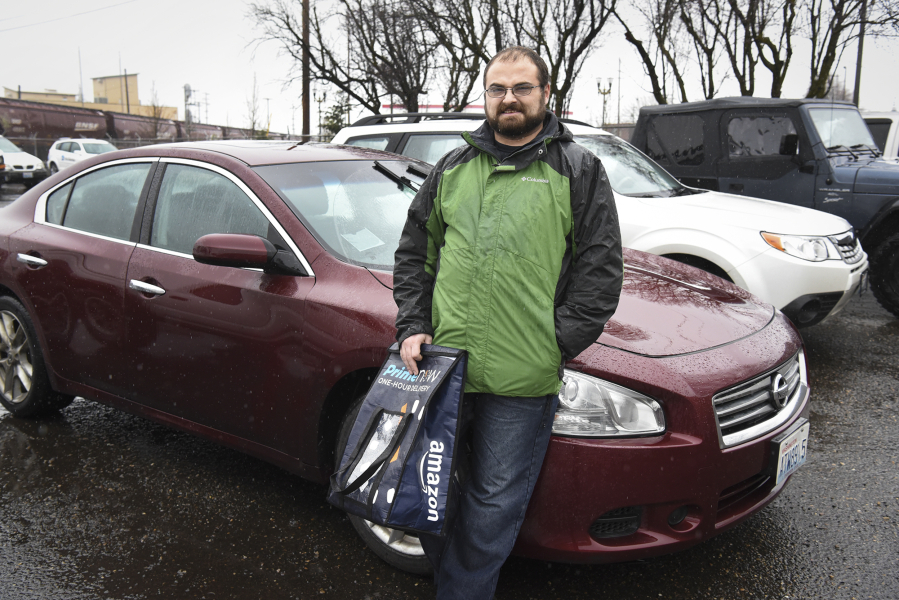BEAVERTON, Ore. — On a misty Wednesday night, James Fowler spent hours driving around the Portland suburbs, directed by the phone affixed to his maroon Nissan’s dashboard.
The 32-year-old Vancouver resident is an Amazon Flex driver. He earns $18 to $25 per hour working through the service, delivering packages and other goods. That night he worked food delivery, so he wheeled around Beaverton, Ore., picking up meals from Asian restaurants and taking them to homes in Portland’s West Hills.
“This is the busiest Wednesday I’ve had in a month,” he said while navigating an uphill bend. “It’s refreshingly nice to drive around and actually work.”
Packages don’t deliver themselves. Not yet, at least.
Advances in technology have made self-driving cars a reality and autonomous delivery trucks are rumored to be close behind. Amazon.com Inc. itself has tantalized customers with drones engineered to fly packages to doorsteps and patented blimps to hover over cities like floating warehouses.
The delivery job still belongs to people for now. Amazon Flex is one relatively quiet campaign that has taken root in the Portland metro area and opened a new avenue for on-demand work for drivers like Fowler.
Flexing muscles
Amazon.com Inc., the Seattle-based online retailer, launched Amazon Flex in 2015. Like the ride-hailing service Uber, it enlists drivers via a smartphone app; instead of people, drivers pick up to-go food, groceries and parcels.
According to the company’s website, the app is available in 22 regions including Portland. Package delivery is available in Vancouver, though for now, food and grocery delivery is not.
Drivers are also checked for driving and criminal history before they are eligible to work through the app, company officials said.
The Amazon Flex app hasn’t received the same attention as ride-hailing services. Some have reported being surprised seeing strangers drop off packages on their porch. Many don’t seem to mind once they figure it out, though.
Marty Porter, an engineer who works from his home in the Shumway neighborhood, said a package of shampoo and conditioner was recently dropped off by an Amazon Flex driver.
“I usually keep my eyes out for anything out of the ordinary on our street and happened to notice a vehicle that I didn’t recognize was in front of our house,” he said. “A few seconds later, there was a knock on my door and there was my wife’s package that she’d ordered.”
Porter, 42, called it a “good service,” but he could understand why some people could be thrown off.
“I didn’t seem to notice any temporary Amazon signage or branding on the vehicle like the window stickers you see with Uber or Lyft, so when the vehicle pulls up, one really has no idea that a package is being delivered,” he said.
Life of a driver
“Beaverton is kind of my specialty,” Fowler said. The married father of four lives in the Vancouver Heights neighborhood and works at least two nights per week.
Much of his night is spent behind the wheel on busy roads in Beaverton, Ore. He prefers suburbia to the city because of its higher speed limits, free parking and relatively uncrowded streets. The tips are better, too, he said.
Fowler estimates he can net between $150 and $200 including tips in a single shift. As with ride-hailing services, the base wages vary according to supply and demand. The pay rises when there are many packages to deliver or too few drivers.
On a couple shifts during the winter snowstorms, Fowler earned $500 a night. His wife’s earnings can support the family, so the Amazon Flex income is supplemental, he said.
Fowler can choose when he picks up shifts like other on-demand jobs. The shifts can run between two and six hours, he said, depending on the number of deliveries. Once Fowler signs in with his phone, the app directs him to waiting packages around the city.
But the work doesn’t come without sacrifice. Driving is sedentary work; it’s tempting to eat fast, unhealthy meals in order to complete jobs quickly, Fowler said.
“There could be a lot to be done to offer rest periods, to encourage people to get out of their car and walk around,” he said. “This is not the kind of job you get lunch breaks on. If you eat, it’s because you planned it.”
Fowler worries about the inherent risks in driving for a living, too. In the snowstorm, Fowler hit a patch of ice on Interstate 5 and almost drove into the median.
He also worries about the toll a long shift can take on drivers’ abilities to focus on the road, similar to the experience of long-haul truckers.
“As a driver and independent contractor, I put it in my own head that maybe I shouldn’t spend more than six hours on the road every day,” he said. “If I do, I get out and walk around and refresh myself — try to make sure I’m not a danger to everyone else. But not everybody thinks like that.”
Pandora’s box
Amazon Flex drivers face similar challenges as others in the gig economy. Largely due to how recently these trends have developed, the law is trying to catch up to the technology.
Some drivers contend they should be considered employees to become eligible for benefits like overtime wages. Three such drivers in Seattle filed a complaint in federal court in October.
Craig Peters, a lawyer with The Veen Firm in San Francisco who has worked on similar cases, said the on-demand workers are considered independent contractors to circumvent employee protections.
“The gig economy is built on deconstruction of that (employer-employee) relationship and having the employer avoid all the protections for workers that go along with the relationship,” he said in an email.
But the on-demand work is exactly what appeals to many drivers who say they want to be their own bosses. Independence, they said, is a two-way street.
“I am not a 9-to-5 kind of guy. I just don’t do that; it doesn’t work for me,” Fowler said. “I’ve done it before. I’ve stuck it out. But I hate it with a passion. This to me is way better. I get to choose what kind of stuff I do, when I do it, how much time I spend doing it.”
Peters said he had not heard of any workers filing suit over deteriorating health, but it was not unheard of for drivers to put in long hours.
“We have heard of people who drive long distances just to get to urban centers, to then drive in the gig economy and end up driving for 14 to 20 hours straight,” he said. “They then sleep in their car, and either do another 14 to 20 hour stint or drive home. None of this is good for drivers or for the public.”
When reached for comment, Amazon said the app allows drivers to work on their own schedule “for up to $25 per hour, freeing up time to pursue their goals and dreams,” the company said, adding that drivers are thoroughly vetted to ensure safety.
“Driver safety is a top priority – on average, participants are on the road for less than six hours per day and sophisticated software is used to plan delivery routes,” the company continued. “As independent contractors, drivers deliver at their own pace, take breaks at their discretion, and are able to choose the suggested route or develop their own.”
Amazon jungle
From a customer’s perspective, having an independent contractor deliver packages might make them feel vulnerable to theft. But Porter, the Shumway delivery customer, said he felt the service might actually diminish theft because criminals already follow marked postal vehicles and package delivery trucks.
“I do think that having deliveries be more discreet will help reduce packages being stolen from homes post-delivery, assuming the package does in fact get delivered correctly,” he said.
The app includes a number of protections to minimize these problems, including background checks for drivers. Customers are able to communicate with the driver and may ask that packages be delivered directly to them, rather than left on the porch.
Fowler predicts the delivery service will grow as much as the company chooses. The company opened a new distribution center in Hillsboro, Ore., last year and plans to open a 855,000-square-foot fulfillment center in Troutdale, Ore., next year.
“People are inherently lazy now,” he said. “There’s nothing more gratifying then downloading an app, browsing through random stuff, and literally having it delivered within an hour if you want.”
That growth stands to benefit drivers like Fowler. At least for as long drivers are needed.




